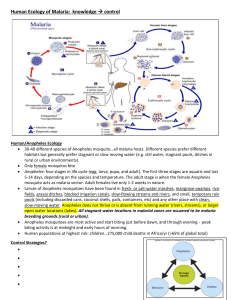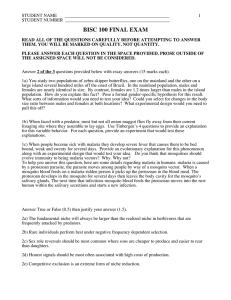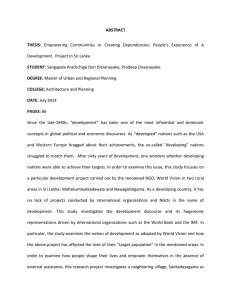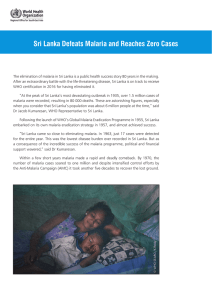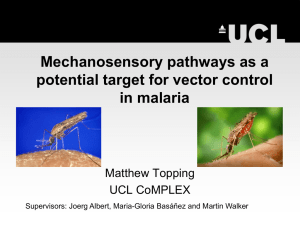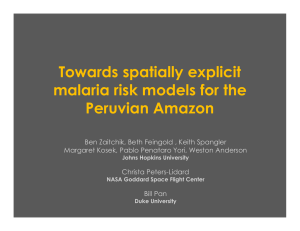Climate Impacts on Malaria Transmission and the Development of Seasonal Distribution
advertisement
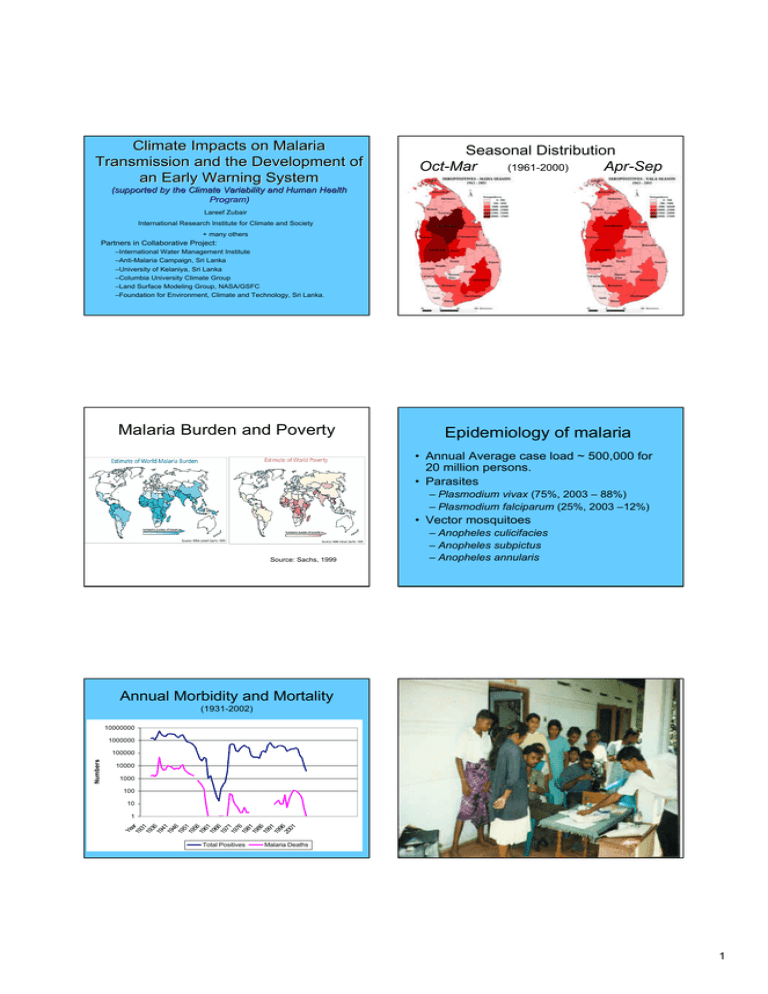
Climate Impacts on Malaria Transmission and the Development of an Early Warning System Seasonal Distribution Oct-Mar (1961-2000) Apr-Sep (supported by the Climate Variability and Human Health Program) Lareef Zubair International Research Institute for Climate and Society + many others Partners in Collaborative Project: –International Water Management Institute –Anti-Malaria Campaign, Sri Lanka –University of Kelaniya, Sri Lanka –Columbia University Climate Group –Land Surface Modeling Group, NASA/GSFC –Foundation for Environment, Climate and Technology, Sri Lanka. Malaria Burden and Poverty Epidemiology of malaria • Annual Average case load ~ 500,000 for 20 million persons. • Parasites – Plasmodium vivax (75%, 2003 – 88%) – Plasmodium falciparum (25%, 2003 –12%) • Vector mosquitoes Source: Sachs, 1999 – Anopheles culicifacies – Anopheles subpictus – Anopheles annularis Annual Morbidity and Mortality (1931-2002) 10000000 1000000 10000 1000 100 10 1 Ye a 19 r 31 19 36 19 41 19 46 19 51 19 56 19 61 19 66 19 71 19 76 19 81 19 86 19 91 19 96 20 01 Numbers 100000 Total Positives Malaria Deaths 1 Elements of an Effective Disease Early Warning System National Academy of Science, Institute of Medicine - Public Health Systems and Emerging Infections, 2000 Risk analysis, Vulnerability Assessment Climate forecasts Epidemiological surveillance Predictive models Disease watch Early warning Environmental observation Response strategy Public communication Evaluation and feedback Malaria and Food Insecurity 0 - 1.25 1.25 - 2.5 2.5 - 5 5 - 10 10 - 20 20 - 40 40 - 80 80 - 160 >160 No Data Workshop on “The development of an early warning system” Annual Temperature and Rainfall 09th December 2003 Uva Management Development Training Institute, Passara Regional Malaria Officers, Department of Health, Provincial government, University researchers, Department of Meteorology Aurelia Micko/OGP Micko/OGP 2 Population and Annual Parasite Incidence Gill, 1936 HURULUWEWA, SRI LANKA Amerasinghe et al • Watershed forest and ancient tank-cascade rice and slash-and-burn agricultural system • 3000 people live in the watershed area within 3 km. of the stream Research in 1994-1999 established that the Yan oya stream was the major malaria vector breeding habitat <Mosquito generation times [>Pop. growth rate] <Mosquito survivorship [<Life expectancy] <Extrinsic incubation period of virus [>Transmission rate] Water >Mosquito oviposition and larval habitats >Mosquito population size [immediate] >Vertebrate host population size [time delay] CURRENT WATER FLOW PATTERN: SIMULATION-1 250 StreamWater Depth (cm) Temperature STREAM STREAMFLOW FLOWand andLARVAE LARVAE 90 CURRENT FLOW Stream water depth 200 Larval abundance 80 70 60 150 50 40 100 30 20 50 Larval Abundance CLIMATE FACTORS IN MOSQUITO-BORNE VIRUS TRANSMISSION 10 0 0 O 1996 N D J F M A M J J A S 1997 Amerasinghe et al. Relative Humidity >Survivorship 3 400 Streams and Model Basins All Years El Nino La Nina Rainfall 300 Rainfall Climatology and ENSO phases 200 100 0 J F M A M J J A S O N D Month Rainfall Climatology during Epidemics and Other Times Annual NINO3.4 with Epidemic Years in Red Modeled Discharge at Peradeniya Modeled Seasonal Soil Moisture Year-Latitude Correlations for Summer Rainfall and Equatorial SST Downscaling With Ward, Ndiaye, Chandimala and Perera 1600 1400 1200 1000 800 600 400 200 0 1980 Observation grd147 Forecast grd147 1985 1990 1995 2000 Zubair and Chandimala, JHM, 2006. 4 What have we learned? • Climate related information is useful. – Ecosystems can be responsive to climate. – Need to work at relevant time scale • Weather/Climate information is needed. • In-depth place-specific, fine-scale hydro-meteorological information and research needed. • Climate information has to be transformed to the salient attributes incorporating environmental, epidemiological and vulnerability information • Partnership, technology development. • This work is labor intensive. IRI’s Mahaweli River Basin Projects January 2000 onwards http://iri.columbia.edu/~mahaweli 5



